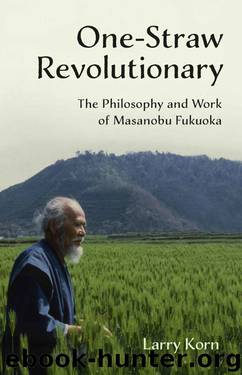One-Straw Revolutionary: The Philosophy and Work of Masanobu Fukuoka by Larry Korn

Author:Larry Korn [Korn, Larry]
Language: eng
Format: epub
ISBN: 9781603585309
Amazon: 1603585303
Goodreads: 26483937
Publisher: Chelsea Green Publishing
Published: 2015-09-14T04:00:00+00:00
The founders of the East West Foundation (now the Kushi Institute) were Michio and Aveline Kushi. They were also students of George Ohsawa in Japan. Like the Aiharas, the Kushis came to the United States to introduce macrobiotics to the West, but their approach and personal styles could not have been more different. The Kushis were much more formal than the Aiharas, and they were very much about business. Besides teaching, they established the Erewhon Trading Co., opened one of the first natural food stores in the Boston area, and published a magazine, the East West Journal, which had a large worldwide circulation.
The Summer Conference was held at Amherst College in western Massachusetts. The campus was landscaped with spacious lawns, flowering ornamental shrubs, and stately trees. Students stayed in dormitories, meals were cooked in the university kitchen, and most of the classes were held in lecture halls. This was a far cry from the French Meadows camp where everyone slept under the stars and the classes were held outdoors with the students sitting cross-legged on the ground. Still, the setting seemed appropriate for the nature of the conference. Sensei and Ayako-san stayed in a private suite and enjoyed interacting with the students very much.
It was a macrobiotic program, so his talks mainly concerned diet and how diet affects clarity of thought, but in one lecture he asked the students to consider the forests of New England. At first glance they seem to be a “sea of green” and quite natural, but he noticed that the soil was poor and seemed to be worn out. Some people told him that was the result of earlier glaciation, but he suspected that the land was cleared for grazing at one time. When the soil became eroded and unproductive it was abandoned for richer soils elsewhere. He suggested that the forests we see today are merely a shadow of what they had been long ago.
“Everywhere we look we see only ourselves, not true nature,” he said. “Take the grounds of this university, for example. It looks lovely with its expansive lawns and large trees, but what you are seeing is people’s aesthetic impression of nature, a pale imitation of the real thing. It reflects the character of the university with its sense of order and self-importance and is designed with human pleasure and convenience in mind. True nature has been banished from this campus. The lawns are pleasant to look and to sit on, but I have not seen any butterflies or insects there. I call lawns ‘artificial green.’ As far as nature is concerned, they might as well be concrete.”
One afternoon between lectures, Sensei did an interview for The Mother Earth News. I had called them a few weeks earlier suggesting the interview, but they had no one available to come to Amherst. We agreed that I would do the interview for them, but I did not mention that to Sensei. At the appointed time I said, “All right, it’s two o’clock, let’s get started.
Download
This site does not store any files on its server. We only index and link to content provided by other sites. Please contact the content providers to delete copyright contents if any and email us, we'll remove relevant links or contents immediately.
| African-American & Black | Australian |
| Chinese | Hispanic & Latino |
| Irish | Japanese |
| Jewish | Native American & Aboriginal |
| Scandinavian |
Becoming by Michelle Obama(9291)
The Last Black Unicorn by Tiffany Haddish(5075)
Beartown by Fredrik Backman(4417)
Man's Search for Meaning by Viktor Frankl(3631)
The Book of Joy by Dalai Lama(3217)
In a Sunburned Country by Bill Bryson(2946)
The Choice by Edith Eva Eger(2895)
The Five People You Meet in Heaven by Mitch Albom(2841)
Full Circle by Michael Palin(2771)
The Mamba Mentality by Kobe Bryant(2667)
The Social Psychology of Inequality by Unknown(2310)
Book of Life by Deborah Harkness(2263)
The Checklist Manifesto by Atul Gawande(2203)
Less by Andrew Sean Greer(2188)
The Big Twitch by Sean Dooley(2043)
No Room for Small Dreams by Shimon Peres(1991)
No Ashes in the Fire by Darnell L Moore(1981)
A Burst of Light by Audre Lorde(1980)
Imagine Me by Tahereh Mafi(1920)
